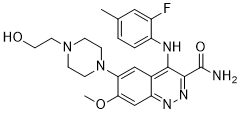| Cas No.: | 1041852-85-0 |
| Chemical Name: | AZD7507 |
| Synonyms: | AZD7507;4-(2-fluoro-4-methylanilino)-6-[4-(2-hydroxyethyl)piperazin-1-yl]-7-methoxycinnoline-3-carboxamide;AMY16926;BDBM50492685;A16886;D77979;4-((2-fluoro-4-methylphenyl)amino)-6-(4-(2-hydroxyethyl)piperazin-1-yl)-7-methoxycinnoline-3-carboxamide |
| SMILES: | FC1C=C(C)C=CC=1NC1=C(C(N)=O)N=NC2C=C(C(=CC=21)N1CCN(CCO)CC1)OC |
| Formula: | C23H27FN6O3 |
| M.Wt: | 454.506 |
| Purity: | >98% |
| Sotrage: | 2 years -20°C Powder, 2 weeks 4°C in DMSO, 6 months -80°C in DMSO |
| Description: | AZD7507 is a potent and orally active CSF-1R inhibitor, with antitumor activity. |
| Target: | CSF-1R[1] |
| In Vivo: | AZD7507 has good rat oral PK, with in vivo clearance of 7 mL/min/kg and 42% bioavailability. In the canine L-type Ca channel assay, the IC50 is >20 μM[1]. AZD7507 significantly decreases the number of CD68+ macrophages in mice, and also reduces the volume and mass in mice bearing CC-LP-1 and SNU-1079 cells, but not WITT-1 cells[2]. |
| In Vitro: | AZD7507 (Compound 31) inhibits the proliferation of 3T3 cells engineered to express CSF-1R and stimulated with CSF-1 (IC50, 32 nM), shows inhibitory activity against hERG and NaV1.5, with IC50s of >30 and 26 μM[1]. |
| Animal Administration: | Mice[2] Male CD1 nude mice are injected subcutaneously with 5 × 105 human ICC cells from human cell line WITT-1, CC-LP-1, or SNU-1079 (n = 24 in all cases) suspended in culture media/RGF Matrigel (Gibco) mix (1:1). Cells are engrafted bilaterally in the flank and allowed to form tumors over 3 weeks. Once palpable tumors have formed, mice are randomized into 3 groups using GraphPad online software. Xenografted mice are injected with liposomal clodronate at 4 μL/g intravenously. The control for this treatment is saline alone or liposomes not containing clodronate (both given at 4 μL/g intravenously). All of these treatments are given every 48 hours for 3 weeks. CSFR1 inhibitors AZD7507 and GW2580 are made up in sterile water containing 0.5% methylcellulose and 0.1% Tween-80. AZD7507 is given twice daily at 100 mg/kg, whereas GW2580 is given daily at 160 mg/kg. Control animals are given water containing 0.5% methylcellulose and 0.1% Tween-80. ICG-001 (5 mg/kg) or C-59 (20 mg/kg) is given by intraperitoneal injection. The vehicle for this is physiological saline. Control animals are given vehicle alone. In all cases inhibitors and vehicle are given 3 times per week[2]. |
| References: | [1]. Scott DA, et al. Mitigation of cardiovascular toxicity in a series of CSF-1R inhibitors, and the identification of AZD7507. Bioorg Med Chem Lett. 2013 Aug 15;23(16):4591-6. [2]. Boulter L, et al. WNT signaling drives cholangiocarcinoma growth and can be pharmacologically inhibited. Send to J Clin Invest. 2015 Mar 2;125(3):1269-85. |

 DC Chemicals' products qualify for U.S. tariff exemptions. We guarantee no price increases due to customs duties and maintain stable supply, continuing to deliver reliable research solutions to our American clients.
DC Chemicals' products qualify for U.S. tariff exemptions. We guarantee no price increases due to customs duties and maintain stable supply, continuing to deliver reliable research solutions to our American clients.





















